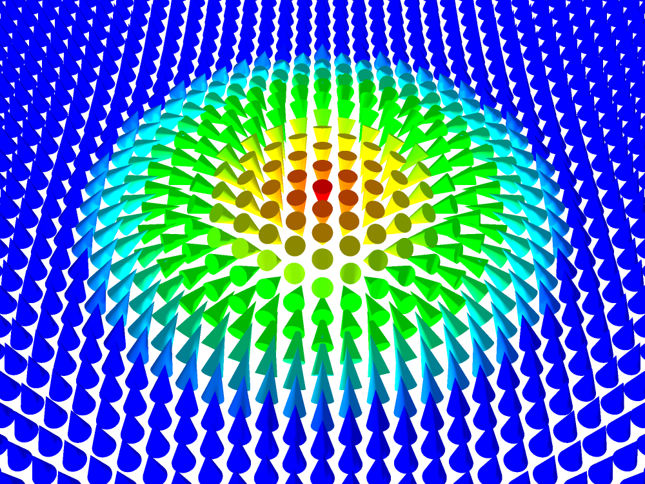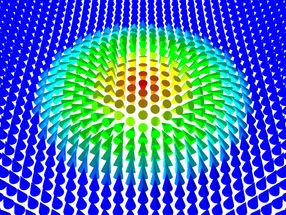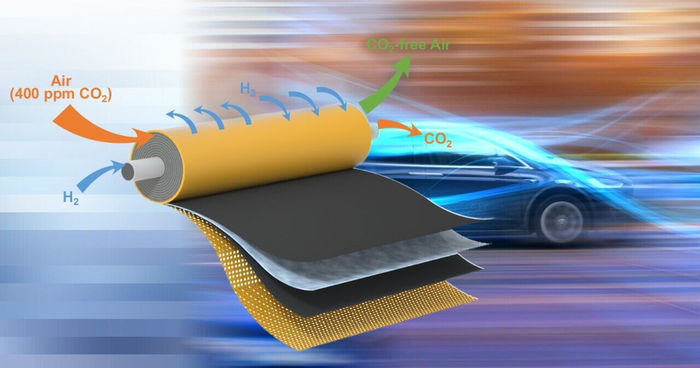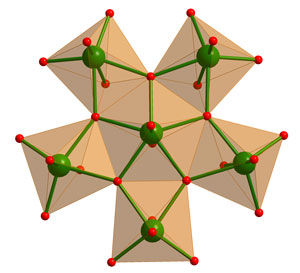Spontaneous occurrence of skyrmions in atomically thin cobalt films observed
Since their experimental discovery, magnetic skyrmions - tiny magnetic knots - have moved into the focus of research. Scientists from Hamburg and Kiel have now been able to show that individual magnetic skyrmions with a diameter of only a few nanometres can be stabilised in magnetic metal films even without an external magnetic field.

Fig. 1: Illustration of a magnetic skyrmion with a diameter of only a few nanometres in an atomically thin cobalt film. The small colored cones represent the "atomic magnets" of each cobalt atom.
© S. Meyer, Kiel University

Fig. 2: Scanning tunneling microscopy measurement of the sample surface, a magnetic skyrmion can be recognized here as a golden ring.
© A. Kubetzka, Universität Hamburg


The existence of magnetic skyrmions as particle-like objects was predicted 30 years ago by theoretical physicists, but could only be proven experimentally in 2009. Skyrmions with a diameter from micrometers to a few nanometers were discovered in different magnetic material systems. Although they can be generated on a surface of a few atoms and manipulated with electric currents, they show a high stability against external influences. This makes them potential candidates for future data storage or logic devices. In order to be competitive for technological applications, however, skyrmions must not only be very small, but also stable without an applied magnetic field.
Researchers at the universities of Hamburg and Kiel have now taken an important step in this direction. On the basis of quantum mechanical numerical calculations carried out on the supercomputers of the North-German Supercomputing Alliance (HLRN), the physicists from Kiel were able to predict that individual skyrmions with a diameter of only a few nanometres would appear in an atomically thin, ferromagnetic cobalt film (see Fig. 1). "The stability of the magnetic knots in these films is due to an unusual competition between different magnetic interactions," says Sebastian Meyer, PhD student in Prof. Stefan Heinze's research group at the Kiel University.
This prediction was subsequently confirmed by Hamburg researchers around Dr. Kirsten von Bergmann using high-resolution scanning tunneling microscopy. The low-temperature measurements by Marco Perini, PhD student in the research group of Prof. Dr. Roland Wiesendanger, show magnetic skyrmions in the prepared cobalt films without an external magnetic field having to be applied (see Fig. 2). "So far, individual skyrmions have almost always been generated by magnetic fields. In our metal films the skyrmions occur spontaneously," explains Kirsten von Bergmann. "For future applications in spinelectronics the skyrmions must not only be stable at extremely low temperatures, as in the metal films investigated, but also at ambient temperature. In order to realize this next step towards application, the competition between different magnetic interactions found here can make a major contribution."
Original publication
Original publication
"Isolated zero field sub-10 nm skyrmions in ultrathin Co films"; Sebastian Meyer, Marco Perini, Stephan von Malottki, André Kubetzka, Roland Wiesendanger, Kirsten von Bergmann, Stefan Heinze; Nature Communications 10, Article number: 3823 (2019)
Organizations
Other news from the department science

Get the chemical industry in your inbox
By submitting this form you agree that LUMITOS AG will send you the newsletter(s) selected above by email. Your data will not be passed on to third parties. Your data will be stored and processed in accordance with our data protection regulations. LUMITOS may contact you by email for the purpose of advertising or market and opinion surveys. You can revoke your consent at any time without giving reasons to LUMITOS AG, Ernst-Augustin-Str. 2, 12489 Berlin, Germany or by e-mail at revoke@lumitos.com with effect for the future. In addition, each email contains a link to unsubscribe from the corresponding newsletter.
Most read news
More news from our other portals
Last viewed contents

Game-changing technology to remove 99% of carbon dioxide from air - Carbon capture advance could bring environmentally friendly fuel cells closer to market

A first-of-its-kind catalyst mimics natural processes to break down plastics - The new catalyst is able to process polymers widely used in things like plastic grocery bags, milk jugs, shampoo bottles, toys, and food containers
Conformational_isomerism
Metropolis-Hastings_algorithm
Jacob_Bruce
Jellium
Estrogen_patch
Margaret_Oakley_Dayhoff
Oxford Instruments achieves the first 22 Tesla at 4.2 Kelvin fully superconducting magnet using LTS and HTS materials
McKesson




























































